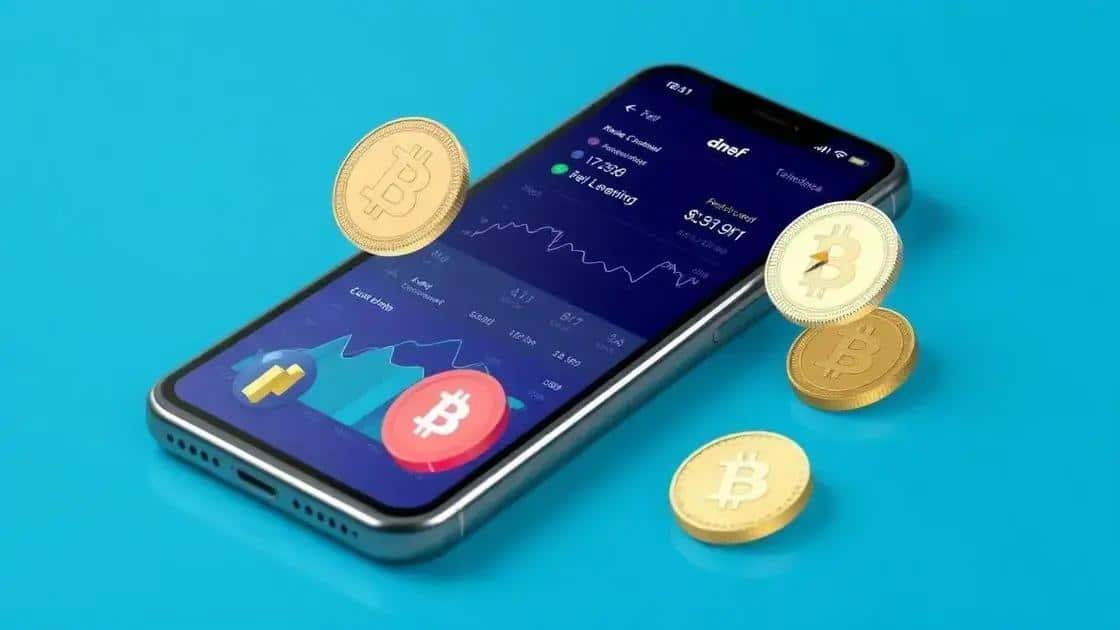DeFi loan platforms trends: what you need to know

DeFi loan platforms provide users with quick access to capital, lower fees, and high returns, while also posing risks like smart contract vulnerabilities and market volatility that users must navigate cautiously.
DeFi loan platforms trends are reshaping how we think about borrowing and lending. Have you ever wondered how these decentralized solutions can make a difference in your financial life? Let’s dive in!
Understanding DeFi loan platforms
Understanding DeFi loan platforms is essential in today’s evolving financial landscape. These platforms are changing the way we think about traditional banking and lending. Have you considered how decentralized finance (DeFi) can enhance your access to loans?
The Basics of DeFi Loan Platforms
At their core, DeFi loan platforms allow users to lend and borrow digital assets without the need for traditional financial institutions. This decentralization eliminates intermediaries and often results in lower fees and faster transactions.
How They Work
Users can deposit cryptocurrencies into a DeFi lending platform and earn interest. On the flip side, others can borrow against these assets by collateralizing their loans. This system minimizes risk for lenders and provides flexibility for borrowers.
- Lending pools allow multiple users to supply funds.
- Smart contracts autonomously handle transactions.
- Borrowers must provide collateral to secure loans.
- Interest rates are often determined by supply and demand.
Why would someone choose DeFi loan platforms? One reason is the ability to access funds without credit checks. If you have cryptocurrency, you can participate without traditional banking hurdles. Moreover, global accessibility means anyone can use these platforms from anywhere in the world, as long as they have an internet connection.
Advantages of Using DeFi for Loans
The benefits of utilizing DeFi loan platforms are substantial. Users experience increased transparency since all transactions are recorded on the blockchain. Additionally, there’s often greater potential for higher returns on investment when lending funds through these platforms as compared to traditional savings accounts.
However, it’s crucial to remember that while DeFi provides numerous advantages, risks are also involved. By engaging with these platforms, users must navigate market volatility and smart contract vulnerabilities.
Latest trends in DeFi lending

The latest trends in DeFi lending showcase how this sector is rapidly advancing and evolving. Many users are increasingly turning to these options as they offer unique opportunities in the lending space.
Decentralized Autonomous Organizations (DAOs)
One notable trend is the rise of Decentralized Autonomous Organizations (DAOs). These entities are managed by smart contracts, providing a transparent and democratic way for users to participate in governance decisions. Users can vote on important changes, ensuring that the community has a say in the platform’s direction.
- DAOs promote community involvement.
- Members can propose and vote on developments.
- This model enhances transparency and trust.
Another significant trend is the growing inclusion of insurance protocols. These protocols help protect users from potential risks associated with smart contracts and lending processes. By providing coverage, they aim to mitigate losses and encourage more users to dive into DeFi lending.
Innovative Collateral Types
The use of innovative collateral types is also being embraced. Traditionally, users had to rely on popular cryptocurrencies, but now platforms are allowing assets like NFTs as collateral. This change opens the door for a broader range of users, making it easier for individuals with various types of digital assets to access loans.
As DeFi lending continues to grow, new features and developments are being introduced. For example, platforms are increasingly incorporating yield farming to boost returns. Users can earn interest by lending their assets while also participating in farming incentives, enhancing overall profitability.
Interoperability is another key trend, allowing different DeFi platforms to communicate and work together seamlessly. This means users can move their assets across various platforms, maximizing their opportunities in lending and earning.
Benefits of using DeFi loan platforms
The benefits of using DeFi loan platforms are significant and appealing for many users. As financial technology evolves, DeFi platforms offer unique solutions that are changing traditional lending.
Access to Capital
One major benefit is the enhanced access to capital. Users can borrow funds quickly without the standard banking requirements like credit scores. This makes services more inclusive and available to a broader range of people. It’s an exciting shift that empowers users who might have struggled to secure loans before.
- No credit checks are required.
- Fast and efficient processing of loans.
- Global accessibility for users anywhere.
- Flexibility in managing loan terms.
Another advantage is the potential for lower interest rates. Since DeFi platforms cut out intermediaries, they often translate those savings into reduced costs for borrowers. This competitive nature encourages better rates, appealing to cost-conscious individuals.
Transparency and Security
Transparency is another critical feature of DeFi loan platforms. All transactions are recorded on a blockchain, making it easy to verify every move. This openness fosters trust among users. Additionally, the security features inherent in blockchain technology help protect users’ funds from fraud and hacking.
Moreover, by using smart contracts, transactions can automatically execute when conditions are met. This reduces the risk of defaults and miscommunication between parties involved in the loan process. It creates a smoother experience for everyone.
Potential for Higher Returns
Investors also benefit from higher returns when lending assets on these platforms. Compared to traditional banks, which may offer minimal interest on savings, DeFi platforms can provide lucrative options. The possibility of earning decent interest rates encourages users to make their assets work for them.
Lastly, many DeFi platforms are continuously innovating, offering new features and services that enhance user experience. This rapid growth means that users often have access to new products that can address their unique needs.
Challenges in DeFi lending

The challenges in DeFi lending are important to understand for anyone looking to participate in this innovative space. While the benefits are clear, there are also risks and obstacles that users must navigate.
Smart Contract Vulnerabilities
One primary challenge is the vulnerability of smart contracts. These contracts govern transactions and automate processes. However, if there are bugs or flaws in the code, users could lose their assets. This risk highlights the need for careful scrutiny and auditing of contracts before engaging with any DeFi lending platform.
- Smart contracts can be exploited by hackers.
- Audits can be costly and time-consuming for developers.
- Users should exercise caution before investing.
Another significant challenge is the issue of liquidity. Many DeFi platforms rely on a pool of assets for lending. If liquidity dries up, it can become difficult for users to access funds or see returns on their investments, leading to frustration and potential losses.
Market Volatility
Market volatility also presents challenges in DeFi lending. Since the value of cryptocurrencies can fluctuate wildly, borrowers may face unexpected issues if the value of their collateral decreases. This situation can result in margin calls or forced liquidations, causing users to lose their assets.
Furthermore, regulatory uncertainty looms over the DeFi sector. As governments and financial institutions explore ways to regulate these platforms, potential restrictions could impact how they operate. Users may face adjustments that could limit their access to services or impose new legal requirements.
Additionally, the complex nature of DeFi can be a barrier for newcomers. Users who are unfamiliar with blockchain technology, wallets, and decentralized applications may struggle to navigate the ecosystem effectively. This knowledge gap can lead to mistakes that could be costly.
Exploit Risks
Certain types of exploitation, like flash loan attacks, demonstrate the risk users face in unregulated environments. These attacks can drain funds from a platform rapidly, leaving individual users vulnerable. It underscores the importance of choosing reputable platforms with a proven track record.
In summary, while the potential of DeFi lending is remarkable, understanding the challenges is crucial. By being aware of these risks and educating themselves, users can better navigate this evolving landscape.
In conclusion, DeFi lending presents exciting opportunities and challenges. While users can enjoy benefits like increased access to funds and lower fees, they must also be aware of potential risks such as smart contract vulnerabilities and market volatility. By being informed and cautious, individuals can navigate this rapidly evolving landscape successfully. Embracing DeFi requires understanding both its advantages and challenges, ensuring a balanced approach to using these innovative platforms.
FAQ – Frequently Asked Questions about DeFi Lending
What is DeFi lending?
DeFi lending allows users to borrow and lend cryptocurrencies without traditional banks, using smart contracts to automate the process.
What are the main benefits of DeFi lending?
The main benefits include easy access to capital, lower fees, and potential higher returns compared to traditional lending options.
What risks should I be aware of in DeFi lending?
Users should consider risks like smart contract vulnerabilities, market volatility, and liquidity challenges.
How can I get started with DeFi lending?
To get started, you need a cryptocurrency wallet, some digital assets, and you can choose a DeFi lending platform that suits your needs.





